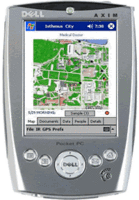
A Review of Bonnie A. Nardi's (
1995)"Studying Context: A Comparison of Activity Theory, Situated Action Models, and Distributed Cognition"
[PDF] (Besides being available as a PDF, it's a chapter in Nardi's (1996)
Context and Consciousness: Activity Theory and Human-Computer Interaction).
This article plugs Activity Theory (AT) and to a lesser extent Distributed Cognition (DC), while throwing a few bones of appreciation to Situated Action (SA) as a small thanks for reminding everyone that things change in the heat of the moment. It's all well-and-well to remember this, says Nardi, but one can hardly build a useful all-encompassing theory based on it. Instead, Nardi backs AT for now, speculating that the three may someday merge into a powerhouse theory.
To sum up the differences:
SA focuses on the "situation" -- what's occurring that spurs on goals and activity. SA says that we're thrown into a situation (defined by the researcher) and goals and activity arise simultaneously, through improvisation, in the immediacy of the situation. Goals are not a condition for action. Suchman, Lave, and Triggs are SA scholars. The unit of analysis in SA is typically very short. 1-1/2 hours at most.
AT focuses on "activity" -- the subject (person), object (objective), (goal-directed) actions, and operations (routinized actions). AT allows for transformation of its objects over time, but not on a moment-by-moment basis. Actions, like driving a car, can become operations as less mental energy is devoted to them, but operations can also return to actions, for example, immediately following an accident or close call one tends to drive more consciously. AT says that the Activity is the context, and it is created by the person, based on his/her historical and developmental changes. AT also allows for Artifacts, created by people to mediate activity (control their own behavior). Artifacts include: instruments, signs, language, and machines. I would suggest that space and place could also be considered artifacts, if they are used consequentially (Schweber 2005, vs. symbolically) as landmarks, shelter, paths, etc. Because AT is predicated on the conscious goal-based action of the subject, it can be analyzed in longer sections. Vygotsky, Leont'ev, Bodker, Kuuti, Wertsch, Davydov, Zinchenko, Talyzina, Christiansen, Engestrom, Escalante, Kozulin, and Norman are cited here.
DC focuses on the "system" -- cooperating individuals and the artifacts they use to complete the cognitive system's (or "functional system's" goals). Flor and Hutchin's 1994 study of shipboard navigation system is the classic article. Others include Miller, Nardi, and Zhang. DC analyses tend to be finely detailed examinations of artifacts, focusing on finding stable design principles.
When Nardi mentions "persistent structures" that extend beyond the duration of the activity, it's interesting that she mentions artifacts, institutions, and cultural values, but doesn't mention spaces which play a huge role in structuring not only activity, but other persistent structures -- artifacts, institutions and cultural values are all deeply influenced by the environment in which they are created, or of which they were created to mediate. To illustrate, consider how the culture of hunting societies or agricultural societies developed, and how they'd develop differently different geographical spaces. "Of the three frameworks, distributed cognition has taken most seriously the study of persistent structures, especially artifacts" (p.42). People and artifacts as "agents" in a system, but Nardi notes that the problem with this is that artifacts can't know anything, they can only be mediums of knowledge (p.43).
What this all means to me is that none of the three really handle space and place well, but DC at least has some room in its structure to deal with it. I'd like to pry that structure open further. If we break "spaces" in three, I could see what Simone Schweber (2005) calls "consequential space" (landmarks, paths, etc. that we've imbued with meaning that directs us) defined as an "artifact". And, I could see what Schweber (2005) calls "symbolic space" (Simone said I could cite her on this ;-)
My concern now turns to how DC will work with my research -- am I really interested in cognition? Or is my concern more about the role of space (consequential and symbolic) in the design and structure of learning environments? And if the latter, am I wasting time looking at DC, or is there an element of it that I can use?







